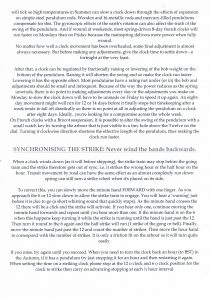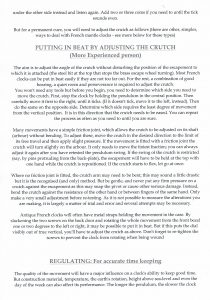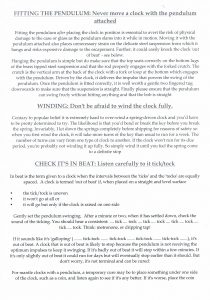Contact the Antique Clock Shop on 0428 923 250
Mechanical clock movement beat-setting
Mechanical clock movement beat-setting means the tick and the tock sound of the clock are even. In order to run, every mechanical clock that has a pendulum needs to be put in beat. It is amazing how many clocks have not run for 10 years or more just because this is not known. Often, clocks in tag sales, auctions, and homes only need to be put in beat to run but unfortunately they were left to sit for years. The setting of the beat is easy and takes less than a couple minutes to do.
Every mechanical pendulum unit needs it
Every mechanical clock that has a pendulum needs to be in beat to function. Part of owning a clock is to know how to do mechanical clock movement beat-setting. If this is not known how to do this, then whenever moving the clock from here to there it will stop after 5-10 minutes. So learning one simple solution will keep the clock running for years.
Putting a post WW2 German clock in beat
By over swinging the pendulum, most modern German mechanical clock movements can be put back into beat. This is also known as Auto Beat and is found in most post WW2 German clock movements. It’s the first thing to try when a clock will not stay running. It is ok to try this even if the clock doesn’t have auto beat built in. If the clock sounds like ticktock ticktock, instead of tick-tock tick-tock, or even tocktick tocktick, then it is not in beat. The clock may stop after 5 minutes, or even an hour, if it is still not in beat. Will also hear an uneven tick and tock. A rhythmic tick-tock tick-tock can be heard when it is correctly in beat.
SETTING UP, PUTTING IN BEAT YOUR PENDULUM CLOCK
A difficult topic to address, as there are quite a few different types of pendulum clocks. Each will require a different approach, although the principle is mainly the same. The issue here is that it always takes a bucket load of words to convey what would only take minutes to show…bear with me.
GOAL: to have your clock running consistently with a steady and even beat.
The word to note here is “beat”. Very much like a heart beat, the beat of your clock should be steady, even and preferably strong. What you are trying to achieve is an even release of power, this is done by the escapement (the top bit that the pendulum hangs on). When a clock/timepiece runs, the sound should be balanced i.e Tick….Tock….Tick….Tock (not Tick..Tock……Tick..Tock).
Bracket/mantle:
Before getting into different types, we need to establish that the clock is “out of beat” and that it is not another problem causing your issues.
By moving the pendulum manually to the left or right, you should get a Tick one way, and a Tock the other. If you do, but it won’t run for any length of time, try wedging the key under one side and see if the “beat” sounds more even. If it does not, try the other side and be prepared to adjust the amount of tilt to gain the best results. If this sorts out the problem and the clock keeps running you have two choices. 1. leave it as it is and except that your lovely timepiece will have to be displayed for eternity with a key shoved under one side, or 2. make an adjustment!!
Making that adjustment!!
When a pendulum hangs in its natural “stopped position”, it should be between receiving power and releasing power (between tick and tock). This natural position will be dictated by the surface it stands on. Although a totally level surface is preferred, how many are there in the normal home….not many!
Place the clock on a flat surface, move the pendulum manually to the left and then to the right. Note which way you have to move it the furthest from center to get the “tick”. If you have to move it more to the right to get the tick, then move it gently to the left until you feel resistance. Once at that point, move it slightly further to the left (this is the adjustment) and then see if it has made the required improvement to the beat, if not repeat the process. (visa versa applies). As with all things, patience and practice will make perfect.
French clock adjustment:
Most French clocks are housed in “drums”. This makes the whole process of adjustment so much easier.
Firstly, loosen off the two screws that hold on the back door. This will allow the whole movement to be turned within the case. Next set the clock in its display position. Gently swing the pendulum while turning the whole movement to the left or right within the case (much like a safe cracker would do). Again, you are listening for that steady, even beat. Once you have it, let it run and once proven, tighten up the screws.
Does not keep time:
This is the other job of the pendulum, to regulate the time keeping. Most pendulums have a screw/nut or some sort of adjustment on the “bob weight”(lump at the bottom of the pendulum). If your clock is running slow, you need to move the weight up the pendulum. If it is running fast, then lower it down. If your pendulum is all the way up or all the way down, you either have the wrong pendulum or the clock requires cleaning.
A few points to note:
1. These are general instructions and can’t be applied to every sort of clock.
2. If your clock is not running, it may not be the set-up that is wrong, it could be mechanical failure.
3. Nothing you do to your clock should ever require “force”.
4. Most clocks only require a minimal mount of adjustment ie mm not miles.



